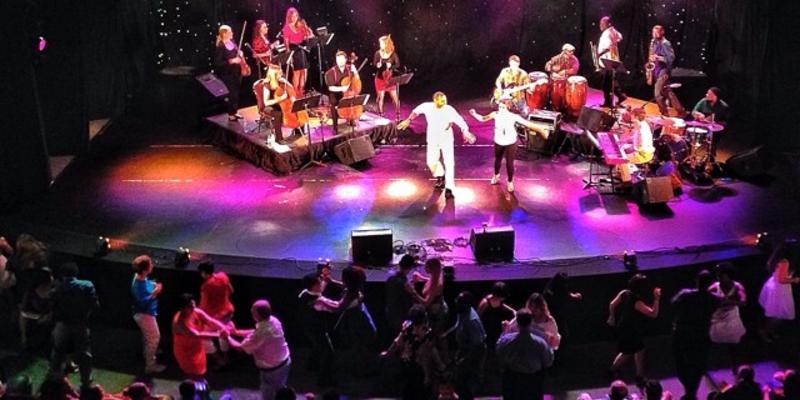
I grew up performing in the dance world. Multiple times a year, I stepped on stage in some combination of tights and tutus, topped off with a healthy dose of hairspray. I was always taught to dance to the person sitting in the last row of the balcony, to perform to unseen, but adoring, masses, who were safely situated behind the 4th wall.
So when Robbi Kenney approached me in 2014 to perform in the first production of Strings and Salsa, my whole concept of performing was turned upside down. The production, merging my favorite local musicians, the Gino Castillo Quartet, with a classical string section headed up by Robbi, was supposed to inspire the audience at the Charleston Music Hall to get up and dance. The tagline was “Go Ahead and Dance in the Aisles.”
My (now) dance partner La Quinn and I weren’t supposed to get on stage and make the audience sit and listen to the music and watch us dance—we were told to have a party, to invite all of the audience members to dance with us.

Before the first show, I was confused and skeptical. What exactly were we doing? We didn’t have choreography for every single song—we had chunks here and there—but a large portion of the show would be based on improvisation. Did anyone even want to watch that?
After the first number of the first show, as La Quinn and I ran through the audience, high-fiving people and waving to our friends, I got it. I understood the point of us being on stage, of being part of the production. We were breaking the ice—showing people what was possible, what they could do.
I was nervous about being judged—afraid people would criticize us for not having fancy footwork or complicated tricks. But that kind of choreography would have created exactly the opposite of the intended effect—it would have intimidated people and made them want to stay in their seats instead of get up and dance themselves.

Throughout the performance, we led some line dances—kind of “Simon Says” type dances where we taught a series of easy-to-follow steps that anyone could join. By the end of the show, half of the audience was on stage dancing with us.
When I was a snowflake in “The Nutcracker” all those years ago, I would have never been able to imagine something like that. Dancing onstage WITH the audience? Unthinkable.
This weekend, we’re performing the fourth run of Strings and Salsa. It’s becoming a mainstay of my performing career and is a production that inspires other people to dance. One of my favorite ladies in the Salsa scene, a retired schoolteacher named Ms. Cindy, came to the first Strings and Salsa and has been a Salsa addict ever since. We performed in Columbia in January, and there were two little girls in the front row who were shy to dance at the beginning of the show, but by the end were the first people to hop up on stage and start dancing.
Strings and Salsa reminds me why I dance—not to be the best, not to look a certain way, not to perfect choreography—but because when there’s good music on, it’s really impossible to sit in your seat.